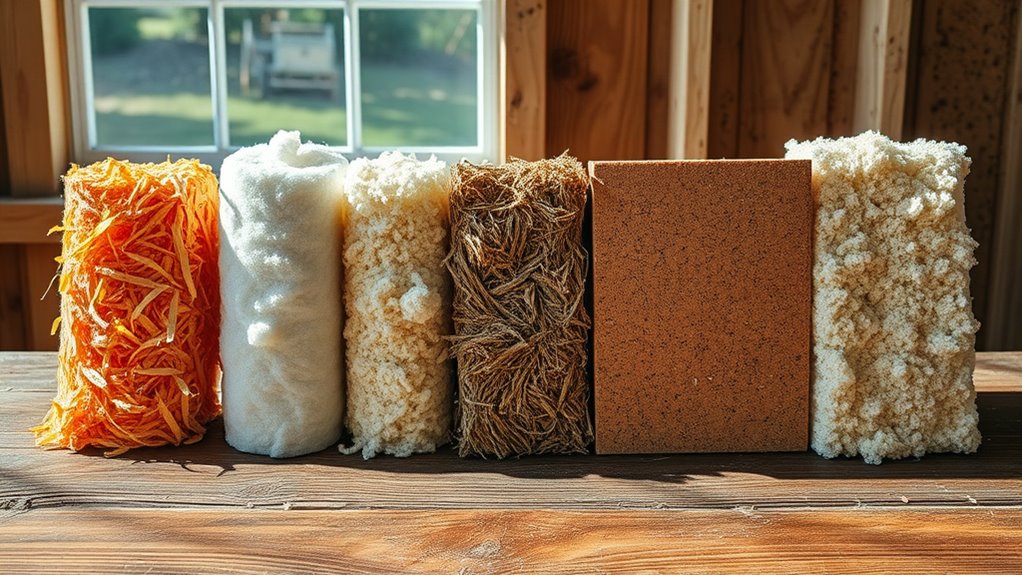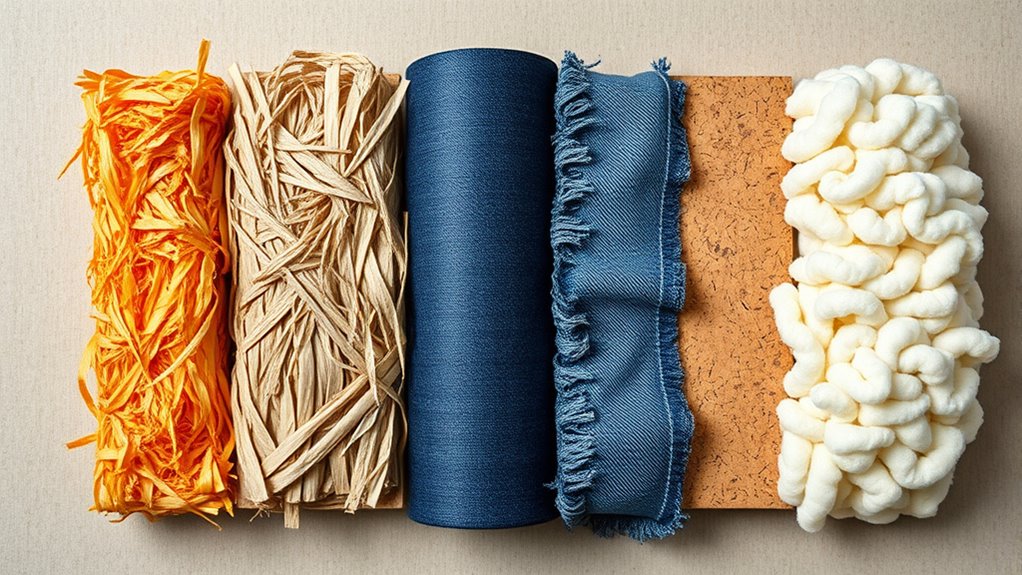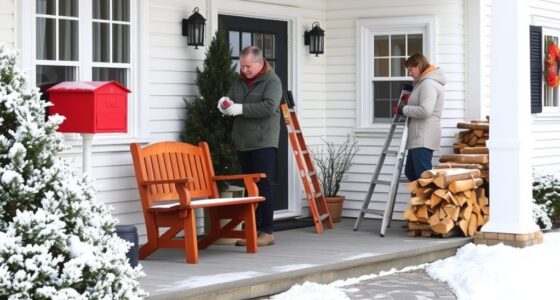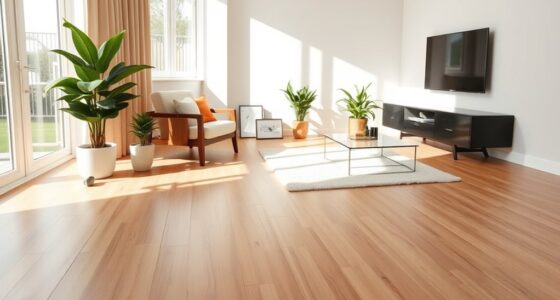You can choose eco-friendly insulation options like denim made from recycled cotton, cellulose from recycled paper, sheep’s wool, hemp, and spray foam with recycled content, which all offer better thermal performance and sustainability. These materials often use innovative recycling systems and proper installation techniques to maximize their benefits. They reduce waste, lower environmental impact, and can be biodegradable or recyclable at end-of-life. Keep exploring to discover how these materials can outperform traditional fiberglass in your projects.
Key Takeaways
- Recycled denim insulation uses recycled cotton, offering superior thermal performance and better soundproofing than fiberglass.
- Cellulose insulation made from recycled paper provides excellent thermal resistance and is treated for fire safety.
- Sheep’s wool insulation naturally manages moisture, reduces mold risk, and outperforms fiberglass in sustainability.
- Hemp insulation is a renewable, biodegradable material with high insulative properties and minimal environmental impact.
- Recycled mineral wool insulation combines fire resistance with eco-friendly manufacturing, surpassing fiberglass in durability and sustainability.

As the demand for sustainable living grows, choosing eco-friendly insulation materials becomes more significant than ever. You want options that not only improve your home’s energy efficiency but also support environmental health. When exploring eco-friendly insulation, it’s vital to consider how these materials are made and installed. Recycling processes play a major role in reducing waste and conserving resources, making sure that the insulation you choose has a smaller ecological footprint. Many sustainable options incorporate recycled content, such as denim insulation made from recycled cotton or cellulose insulation derived from recycled paper products. These materials often undergo specialized recycling procedures that transform waste into valuable building components, minimizing landfill contributions. Additionally, understanding proper installation techniques is key because correct application maximizes insulation performance and longevity. Unlike traditional fiberglass, which can be challenging to install without causing irritation or gaps, eco-friendly options often come with user-friendly installation methods that guarantee even coverage and optimal thermal performance. Proper installation methods are especially important for maintaining the insulation’s thermal efficiency.
For example, cellulose insulation is typically blown into walls and attics, allowing you to fill cavities thoroughly and efficiently. This technique reduces air leaks and enhances energy savings. Similarly, natural fiber insulations like sheep’s wool or hemp batts are designed to be easy to cut and fit, making DIY installation straightforward while maintaining consistent coverage. Proper installation not only boosts insulation effectiveness but also minimizes material waste and reduces the need for rework, aligning with sustainable practices. Incorporating recycling processes into the manufacturing chain ensures that these eco-friendly materials maintain their environmental benefits and continue contributing to waste reduction. Furthermore, many manufacturers now implement closed-loop recycling systems, which help to recycle manufacturing byproducts and reduce overall waste. These innovations further decrease the environmental impact of your insulation choice. Moreover, some eco-friendly options are biodegradable or recyclable at the end of their lifespan, making disposal less harmful to the environment. Recycling processes are integral to this sustainability, allowing used or surplus insulation to be repurposed rather than ending up in landfills. This closed-loop approach ensures that your investment in eco-friendly insulation continues to benefit the environment long after installation. In conclusion, by understanding the recycling processes behind eco-friendly materials and following proper installation techniques, you set yourself up for a more sustainable, energy-efficient home. These efforts help reduce your carbon footprint and promote a healthier planet, all while providing superior insulation performance compared to traditional fiberglass options.
Frequently Asked Questions
How Do Eco-Friendly Insulation Materials Compare in Cost to Fiberglass?
When comparing eco-friendly insulation materials to fiberglass, you’ll find that the cost comparison varies. Eco-friendly options often have a higher upfront price, but they can save you money long-term through better energy efficiency and durability. Considering your budget considerations, it’s worth weighing the initial investment against potential savings. While fiberglass may be cheaper initially, eco-friendly materials might offer more value over time, making them a smart choice in the long run.
Are Eco-Friendly Insulation Options Suitable for All Climate Zones?
You might worry eco-friendly insulation isn’t suitable for all climates, but many options excel across diverse conditions. These materials offer impressive thermal performance and moisture resistance, ensuring comfort and energy efficiency regardless of where you live. Whether it’s cold or humid, eco-friendly insulations adapt well, providing sustainable solutions that outperform traditional fiberglass. So, you can confidently choose eco-friendly options knowing they’ll meet your climate needs and protect your home.
What Is the Typical Lifespan of These Eco-Friendly Insulation Materials?
You wonder about the lifespan of eco-friendly insulation materials. Typically, these materials undergo durability testing to guarantee they last 50 to 100 years, comparable to traditional options. They usually require minimal maintenance, like occasional inspections for damage or moisture. Proper installation and regular checks help maximize their longevity, making them a reliable, sustainable choice for your home’s insulation needs.
Do Eco-Friendly Insulations Require Special Installation Techniques?
While eco-friendly insulations often seem straightforward, they can present unique installation challenges. You might need specialized equipment or techniques to guarantee proper placement and performance. Unlike traditional methods, these materials sometimes require gentle handling or specific tools to avoid damage. Being aware of these equipment requirements and installation challenges helps you achieve ideal insulation results, ensuring your eco-friendly choice truly outperforms fiberglass in efficiency and sustainability.
Are There Any Health Risks Associated With Eco-Friendly Insulation Materials?
You might wonder if eco-friendly insulation poses health risks. Generally, these materials are safer because they emit fewer chemicals, which helps improve indoor air quality. Unlike traditional options, eco-friendly insulations have low chemical emissions, reducing the risk of respiratory issues or allergies. However, it’s still important to guarantee proper installation and ventilation to minimize any potential health concerns and maintain a healthy indoor environment.
Conclusion
By choosing eco-friendly insulation like cellulose, you not only reduce your environmental impact but also enjoy better energy efficiency. For instance, a homeowner in Oregon switched to cellulose insulation and saw a 20% drop in heating bills within the first year. Making greener choices like this helps protect the planet and saves you money long-term. So, next time you’re upgrading your home, consider these sustainable options—they outperform fiberglass and support a healthier environment.
Amina brings over a decade of journalism experience to her role as Editor-in-Chief. Under her leadership, Exquisite Post has flourished, maintaining the highest standards of integrity and excellence. Amina’s commitment to truth and her visionary approach guide the editorial team in producing impactful news stories that resonate with our audience.










